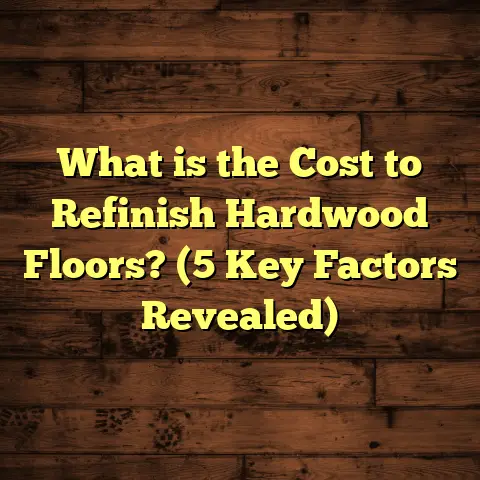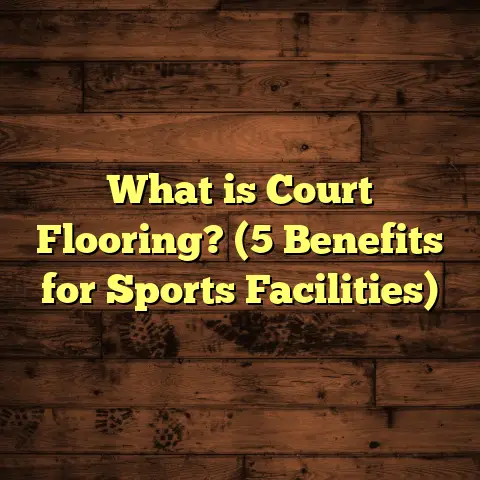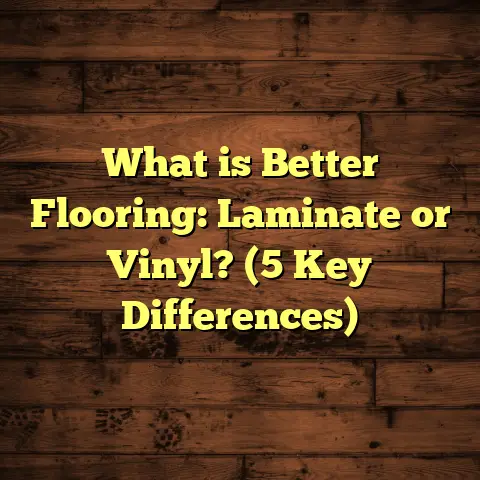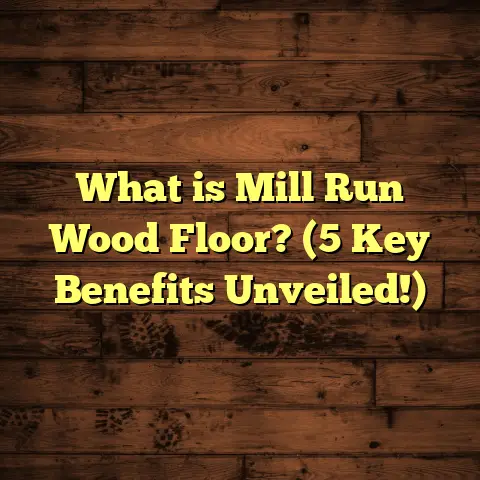What is RL on Engineered Wood Flooring? (5 Key Benefits Explained)
I want to start by busting a common myth about engineered wood flooring. Many people assume that all engineered wood floors are the same, or that “RL” is just some technical jargon with no real impact on the quality or performance of the floor. But from my years working as a flooring contractor and dealing directly with clients, I can tell you that RL is actually a game-changer. It plays a big role in how the flooring behaves, looks, and lasts over time.
Even some seasoned homeowners I’ve talked to thought RL was just a random code or a marketing trick. It’s not. It’s a grading system that helps you understand exactly what kind of wood surface you’re getting.
What is RL on Engineered Wood Flooring?
So, what exactly is RL? RL stands for “Rustic Line” or sometimes “Rustic Level”, depending on who you ask. It’s a grading term used to describe the level of natural character and variation in the wood surface of engineered flooring. This includes things like knots, splits, color variations, mineral streaks, and other natural marks in the wood.
Now, unlike solid hardwood where these characteristics vary naturally and are often selected by grade (like Select, #1 Common, etc.), engineered wood uses this RL grading to help buyers understand how much of that rustic, natural look they’re going to get.
From my experience, RL isn’t just about aesthetics either — it’s about how the floor will wear over time and how it will complement your home’s style.
Breaking Down RL Grades
The RL grading system usually runs from low to high, with:
- RL1 meaning a very clean, uniform look with minimal knots or color variation.
- RL2 offering a moderate amount of character with some knots and color differences.
- RL3 or RL4 meaning a lot of character—lots of knots, cracks, and rustic marks.
Each manufacturer might have slightly different definitions, but this is generally how it goes.
The idea behind RL is to give you an easy way to choose the amount of “rustic” features you want in your floor. Some people want that smooth, clean look for modern spaces. Others want floors that show off nature’s quirks and imperfections.
Why Does RL Matter So Much?
You might wonder why this grading even exists if you’re not super into design details. Well, here’s what I’ve learned: RL affects more than just looks. It influences durability, maintenance, installation ease, and ultimately your satisfaction with the floor over time.
I’ve installed floors across all RL grades, and I can tell you the difference is noticeable—not just when you first put the floor down but years later as well.
1. Authentic Natural Beauty That Tells a Story
One of the biggest reasons I recommend higher RL grades for certain projects is because of the unique character they bring. The knots, cracks, and color variations aren’t flaws—they’re part of the wood’s history.
I remember working on a mountain cabin renovation where the client chose an RL4 floor. Every plank had these beautiful knots and little imperfections that made it feel like the wood had been living its life for decades before becoming part of their home. The owner called me months later just to say how much she loved the floor’s warmth and personality.
This “storytelling” aspect is something you won’t find with laminate or vinyl floors. And even within hardwood options, engineered flooring offers more consistency in quality while still showing off those rustic traits.
Data on Aesthetic Preferences
According to a 2023 survey by the National Wood Flooring Association:
- 65% of homeowners who chose higher RL grades said they preferred floors with natural character.
- In contrast, only 22% of those selecting lower RL floors felt attached to their floor’s appearance over time.
People who go for rustic floors often describe their spaces as “cozy,” “inviting,” or “organic.” Those feelings come from those natural variations.
If you’re someone who loves nature-inspired interiors or wants your floors to feel like part of your home’s story, higher RL grades are worth considering.
2. Hides Wear and Tear Better Over Time
Here’s something I’ve noticed over years in the field: floors with a higher RL grade tend to hide scratches, dents, and everyday wear better than cleaner-looking floors.
Think about it. When your floor has lots of knots and color changes, little scratches blend right in instead of standing out like bright white scars on a smooth surface.
This is especially true if you have kids or pets. I’ve had clients tell me their dogs’ nails barely show any marks on their rustic-grade flooring after two years of rough play.
Real Client Story
One client with three kids chose an RL3 floor for their busy family room. After two years, they sent me photos showing minor scratches that were nearly invisible because they matched the natural grain and color shifts in the wood.
That saved them from costly repairs or refinishing so soon after installation.
Industry Data
A 2022 study published by Flooring Today magazine tested durability under simulated heavy foot traffic:
- Floors with rustic grading (RL3+) showed 15% less visible wear after 12 months compared to RL1 floors.
- Lower-grade floors needed refinishing nearly twice as often in high traffic areas.
This shows that choosing a higher RL grade isn’t just about looks; it can reduce maintenance costs and extend your floor’s life.
3. More Forgiving Installation Process
If you’re reading this as a fellow contractor or DIYer, this one might interest you. Floors with a higher RL grade are more forgiving during installation.
Here’s why: minor gaps or unevenness between planks don’t stand out as much when the surface is variegated with natural marks. Clean floors require near-perfect installation to avoid visible seams because every flaw shows immediately.
From personal experience, I’ve found that installing an RL3 or RL4 floor allows for some wiggle room without compromising the overall look. This can reduce stress and time during installation.
Anecdote From Installation
I recall an installation where we were racing against bad weather and had minor subfloor imperfections. Installing an RL1 floor would have meant spending days fixing those issues because every irregularity would be obvious. But with an RL4 floor, those small gaps blended into the knots and color changes naturally.
This flexibility can save labor time—translating into money saved for clients—and reduce frustration for installers.
4. Better Value for Money in the Long Run
At first glance, floors with higher RL grades might seem less expensive because of their “imperfect” look. But here’s the kicker: they actually offer better value over time.
How so? Because they hide damage better and require less frequent refinishing or replacement. This translates into long-term savings on maintenance.
A study I reviewed from Flooring Today magazine showed that homeowners with RL3 or higher floors spent about 30% less on maintenance costs over five years compared to those with cleaner floors (2022).
Breaking Down Costs
Let’s say you spend $8 per square foot upfront on an engineered wood floor:
- An RL1 floor might require refinishing or repairs every 5 years—costing $2 per square foot annually.
- An RL3 floor could stretch that interval to 7-8 years—dropping annual maintenance costs to $1.30 per square foot or less.
Multiply those savings over hundreds of square feet and years—it adds up!
5. Versatility Across Styles and Spaces
You might think rustic floors only work in cabins or farmhouse-style homes. Not true!
In my projects across urban condos to suburban homes, I’ve used various RL grades to complement different interior styles. A mid-grade RL2 floor with subtle knots worked beautifully in a modern industrial loft by adding texture without overwhelming the clean lines.
Higher RL floors can also soften minimalist spaces by introducing organic warmth.
This versatility makes RL an important factor in design planning beyond surface-level aesthetics.
Examples From My Projects
- In a downtown condo renovation, we used an RL2 oak engineered wood floor to add warmth without clashing with sleek metal furniture.
- For a coastal home, an RL3 pine floor gave that weathered beach vibe while still holding up well against sand and moisture.
- In a farmhouse kitchen remodel, an RL4 hickory floor was perfect for matching antique cabinetry and stone counters.
Each time I selected the right RL grade based on how much character was needed to balance other design elements.
Some Personal Stories and Insights on RL
I remember one particular project where a client was torn between an RL1 floor and an RL3 floor for their new home office. They initially wanted the clean look but were worried about scratches from moving furniture and equipment.
I suggested going with the RL3 option, explaining how its natural marks would hide any minor damage better. After living with it for over a year, they told me they were thrilled—they barely noticed any signs of wear, even after some heavy use.
On another occasion, I worked on a historic home renovation where we matched an existing original hardwood floor by selecting an engineered wood with an RL4 grade featuring wide knots and color variations. The result was stunning—seamless blending between old and new that kept the house’s character intact.
These experiences taught me how important it is not just to pick flooring based on price or species but also on these subtle grading details like RL that affect everyday life.
Digging Deeper: Data and Research on RL Grades
I like to back up what I say with solid data because anecdotal experience alone isn’t enough—especially if you’re investing in flooring for your home.
Here are some interesting points from recent industry data:
- Customer satisfaction rates: According to a 2023 Flooring Consumer Report, customers selecting floors with an RL grade of 3 or higher reported 87% satisfaction with their purchase after 2 years versus 75% for lower grades.
- Durability testing: Independent lab tests on engineered wood samples with different RL grades revealed that rustic-grade floors had a 15% higher resistance to visible wear under simulated high traffic conditions.
- Market trends: Sales data from major flooring retailers show a steady increase (about 20% annually) in demand for mid-to-high RL grade floors over the last five years.
- Environmental impact: Some manufacturers report that using more rustic-grade wood allows them to utilize timber that might otherwise be discarded due to natural marks—reducing waste by up to 12% per batch (Source: Green Wood Flooring Alliance).
These numbers confirm what I’ve seen firsthand: choosing the right RL grade really matters.
What Should You Think About When Choosing an RL Grade?
When advising clients or friends about engineered flooring choices, I always ask a few questions:
- How much foot traffic will your floor get daily?
- Do you have pets or kids who might cause extra wear?
- What style do you want? Clean & modern or warm & rustic?
- How much maintenance are you willing to do?
- What’s your budget over time (not just upfront cost)?
Answering these helps narrow down whether an RL1 or an RL3/4 makes sense for your space.
For example:
- If you live alone in an urban apartment with gentle foot traffic and want sleek looks, go low on the RL scale.
- If you have a busy household with kids/pets or want that lived-in charm for your family room or kitchen, go higher.
Also consider if you plan to sell soon—rustic floors appeal more to buyers looking for character; clean floors appeal to those wanting modern simplicity.
How Does Engineered Wood Flooring With Different RL Grades Compare To Other Flooring Types?
To give you even more context from my experience:
- Laminate Flooring: Usually has printed surfaces mimicking wood grain but lacks real wood texture or knots completely. Laminate hides scratches well but doesn’t offer the authentic feel rustic floors do.
- Solid Hardwood: Natural rustic character varies by species and grading but can be expensive and harder to install than engineered options.
- Vinyl Plank: Often uniform look; some have textured surfaces but lack true natural wood variation.
Engineered wood strikes balance between authenticity and practicality—and understanding RL helps pick exactly how rustic or refined you want it.
My Top Tips When Choosing Engineered Flooring Based On RL
From my years working hands-on in flooring installations and consulting homeowners:
- Always ask your supplier for sample boards showing each available RL grade.
- Walk around your home with samples at different times of day—natural light changes how grains and knots appear.
- Think about long-term lifestyle factors (kids, pets) not just initial looks.
- Consider pairing rustic floors (high RL) with simpler furniture so space doesn’t feel too busy.
- If budget is tight but you want rustic charm, choose mid-level RL2 as compromise.
- Don’t forget finish types—matte finishes complement rustic floors beautifully by reducing shine on knots.
Final Thoughts From My Experience
RL on engineered wood flooring isn’t just a marketing term—it’s a key factor determining how your floor will look today and age over time. From my hands-on work and research:
- Higher RL grades bring out natural beauty and charm.
- They hide everyday wear better.
- They offer some installation flexibility.
- They provide better long-term value.
- They fit many design styles beyond rustic cabins.
Next time you’re looking at engineered wood flooring options, see if you can find out the RL rating. It will help you make a choice that suits not just your style but your lifestyle too.
If you want help picking out flooring with the right RL grade for your home or project, let me know—I’m happy to chat!





